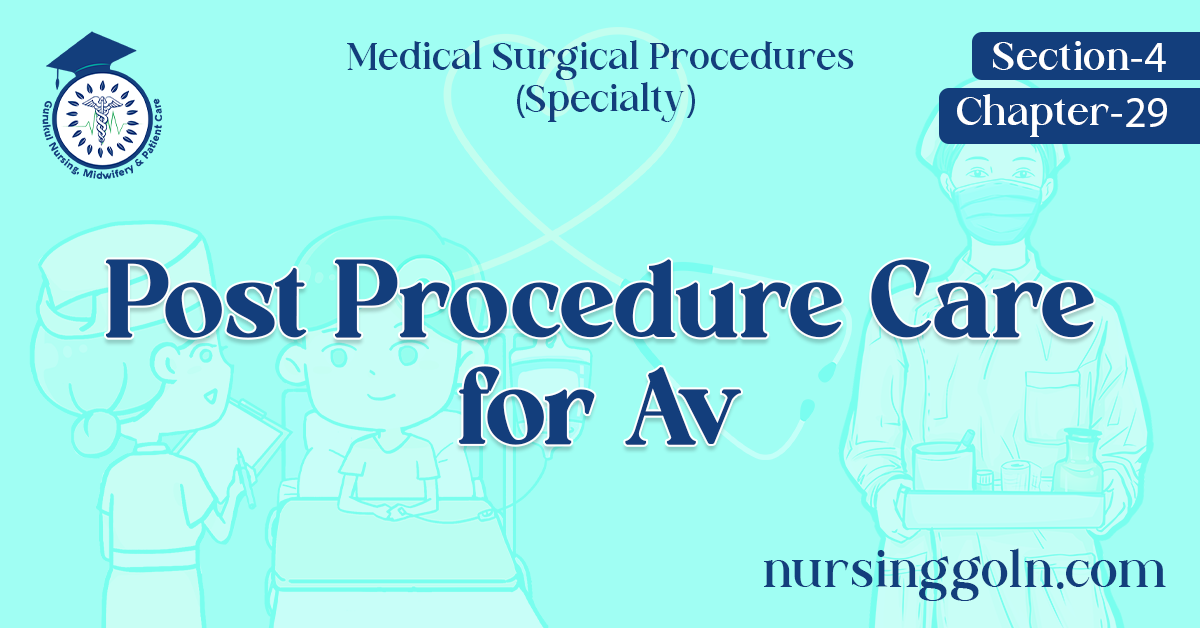Today our topic of discussion is Post Procedure Care for Av.
Post Procedure Care for Av

Postprocedure Care for AV Fistula
- Wash the hands and turn the blood pump of machine to 50-100 ml. per minute hemodialysis
- Put on clean gloves; remove the tape from the connection site of arterial lines
- Clamp the needle tubing with hemostat and disconnect the line
- Blood in the arterial line will continue to flow towards the dialyzer followed by a column of air, just before the blood reaches the point where the saline solution enters the line clamp the blood line with another hemostat
- Unclamp the saline solution and allow small amount to flow through the line
- Unclamp the hemostat on machine line
- After the blood is retransfused clamp the venous needle tubing and machine venous line with hemostat, turn off the blood pump
- Remove the tape from the connection site of venous line and disconnect the lines
- Remove the venous puncture needle and apply pressure with a folded gauze pad (4″ x 4″)
- Apply adhesive bandage and repeat the procedure on the arterial line
- When the procedure is complete check the patient’s weight and mental status
- Compare the findings with redialysis assessment date
- Document the findings
- Disinfect and rinse the delivery system.
Role of Nurse in Care of Patient on Hemodialysis with AV Shunt
- Remove the bull dog clamps and shunt the dressing and clean it using aseptic technique
- Clean the bull dog clamp with alcohol sponge
- Assemble the shunt adaptors
- Clean the arterial and venous shunt, use separate sponge for each shunt and wipe in one direction from insertion site to connection site
- Allow the tubing to air dry .
- Put on sterile gloves
- Clamp the arterial side of the shunt with bulldog clamp and also the venous site, when the shunt is open .
- Open the shunt by separating its side with your finger.

- Both side of the shunt should be exposed
- Adapt the shunt to the lines of the machine.
- Attach a shunt adapter and 10 mL syringe filled with 8 ml. of normal saline to the side of the shunt containing Teflon connector .
- Attach a new Teflon connector to another side of the shunt with second adapter: attach it also with 10 mL syringe filled with 8 mL of normal saline to the same side
- Next flush the shunt arterial tubing by releasing the clamp and aspirate the saline solution, and then flush the tubes slowly repeat the procedure on the venous side.
- Secure the shunt to the adapter with the adhesive tape.
- Connect the arterial and venous line to the adapter.
Postprocedure Care for AV
- Wash the hands .
- Turn the blood pump on the hemodialysis machine to 50-100 mL per minute.
- Put sterile glove and remove the tape from the connection site of the arterial lines.
- Clamp the arterial cannula with the bull dog clamp and then disconnect the lines.
- Blood in the arterial line will continue to flow toward the dialyzer followed by a column of air, just before the blood reaches the point where the saline solution enters the line clamp the blood line with another hemostat .
- Unclamp the saline solution and allow small amount to flow through the line .
- Unclamp the hemostat on machine line, just before the last volume of blood enters the patient clamp the venous cannula with bull dog clamp and machines venous lines with hemostat.
- Remove the tape from connection site of venous line.
- Turn off the blood pump and disconnect the lines .
- Reconnect the shunt cannula, remove older two Teflon connectors and discard, connect the shunt and take care that position of the Teflon connector is equal between the two cannulas.
- Remove the bull dog clamps .
- Secure the shunt connection with hypoallergenic tape .

- Clean the shunt and the site with gauze pads soaked in povidone-iodine solution.
- Make sure the blood flow through the shunt adequately .
- Apply the dressing to the shunt site and wrap it securely with elastic gauze bandage .
- Attach the bull dog clamps to the outside dressing.
- When the hemostat is complete check the vital signs and the mental status.
- Compare the findings with the predialysis assessment data.
- Document the finding.
- Disinfect and rinse the delivery system.
Read more:
